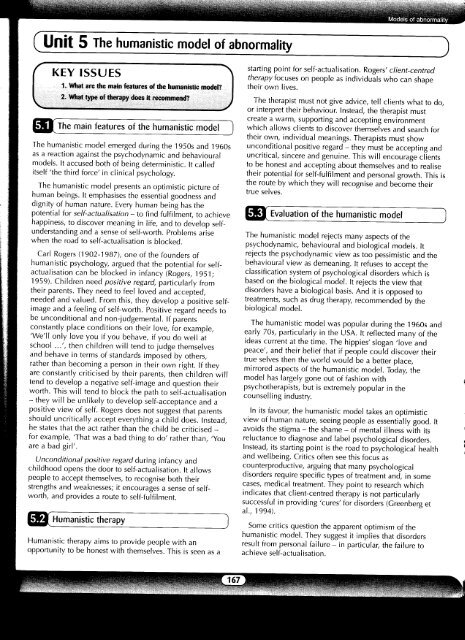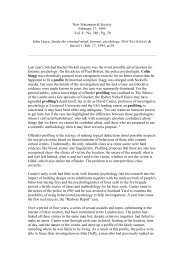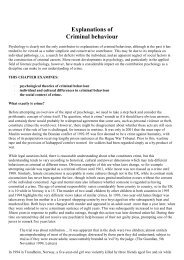Ch 11 - Jeff Standen
Ch 11 - Jeff Standen
Ch 11 - Jeff Standen
You also want an ePaper? Increase the reach of your titles
YUMPU automatically turns print PDFs into web optimized ePapers that Google loves.
Unit 5 The humanistic model of abnormality<br />
KEY ISSUES<br />
1. What are the main features of the humanistic model?<br />
2. What type of therapy does it recommend?<br />
The main features of the humanistic model<br />
The humanistic model emerged during the 1950s and 1960s<br />
as a reaction against the psychodynamic and behavioural<br />
models. It accused both of being deterministic. It called<br />
itself 'the third force' in clinical psychology.<br />
The humanistic model presents an optimistic picture of<br />
human beings. It emphasises the essential goodness and<br />
dignity of human nature. Every human being has the<br />
potential for self-actualisation - to find fulfilment, to achieve<br />
happiness, to discover meaning in life, and to develop selfunderstanding<br />
and a sense of self-worth. Problems arise<br />
when the road to self-actualisation is blocked.<br />
Carl Rogers (1902-1987), one of the founders of<br />
humanistic psychology, argued that the potential for selfactualisation<br />
can be blocked in infancy (Rogers, 1951;<br />
1959). <strong>Ch</strong>ildren need positive regard, particularly from<br />
their parents. They need to feel loved and accepted,<br />
needed and valued. From this, they develop a positive selfimage<br />
and a feeling of self-worth. Positive regard needs to<br />
be unconditional and non-judgemental. If parents<br />
constantly place conditions on their love, for example,<br />
'We'll only love you if you behave, if you do well at<br />
school ...', then children will tend to judge themselves<br />
and behave in terms of standards imposed by others,<br />
rather than becoming a person in their own right. If they<br />
are constantly criticised by their parents, then children will<br />
tend to develop a negative self-image and question their<br />
worth. This will tend to block the path to self-actualisation<br />
- they will be unlikely to develop self-acceptance and a<br />
positive view of self. Rogers does not suggest that parents<br />
should uncritically accept everything a child does. Instead,<br />
he states that the act rather than the child be criticised -<br />
for example, 'That was a bad thing to do' rather than, 'You<br />
are a bad girl'.<br />
Unconditional positive regard during infancy and<br />
childhood opens the door to self-actualisation. It allows<br />
people to accept themselves, to recognise both their<br />
strengths and weaknesses; it encourages a sense of selfworth,<br />
and provides a route to self-fulfilment.<br />
|^j[7iumartistic therapy<br />
Humanistic therapy aims to provide people with an<br />
opportunity to be honest with themselves. This is seen as a<br />
starting point for self-actualisation. Rogers' client-centred<br />
therapy focuses on people as individuals who can shape<br />
their own lives.<br />
The therapist must not give advice, tell clients what to do,<br />
or interpret their behaviour. Instead, the therapist must<br />
create a warm, supporting and accepting environment<br />
which allows clients to discover themselves and search for<br />
their own, individual meanings. Therapists must show<br />
unconditional positive regard - they must be accepting and<br />
uncritical, sincere and genuine. This will encourage clients<br />
to be honest and accepting about themselves and to realise<br />
their potential for self-fulfilment and personal growth. This is<br />
the route by which they will recognise and become their<br />
true selves.<br />
I^J^Evaluation of the h umanistic model<br />
The humanistic model rejects many aspects of the<br />
psychodynamic, behavioural and biological models. It<br />
rejects the psychodynamic view as too pessimistic and the<br />
behavioural view as demeaning. It refuses to accept the<br />
classification system of psychological disorders which is<br />
based on the biological model. It rejects the view that<br />
disorders have a biological basis. And it is opposed to<br />
treatments, such as drug therapy, recommended by the<br />
biological model.<br />
The humanistic model was popular during the 1960s and<br />
early 70s, particularly in the USA. It reflected many of the<br />
ideas current at the time. The hippies' slogan 'love and<br />
peace', and their belief that if people could discover their<br />
true selves then the world would be a better place,<br />
mirrored aspects of the humanistic model. Today, the<br />
model has largely gone out of fashion with<br />
psychotherapists, but is extremely popular in the<br />
counselling industry.<br />
In its favour, the humanistic model takes an optimistic<br />
view of human nature, seeing people as essentially good. It<br />
avoids the stigma - the shame - of mental illness with its<br />
reluctance to diagnose and label psychological disorders.<br />
Instead, its starting point is the road to psychological health<br />
and wellbeing. Critics often see this focus as<br />
counterproductive, arguing that many psychological<br />
disorders require specific types of treatment and, in some<br />
cases, medical treatment. They point to research which<br />
indicates that client-centred therapy is not particularly<br />
successful in providing 'cures' for disorders (Greenberg et<br />
al., 1994).<br />
Some critics question the apparent optimism of the<br />
humanistic model. They suggest it implies that disorders<br />
result from personal failure - in particular, the failure to<br />
achieve self-actualisation.<br />
167







